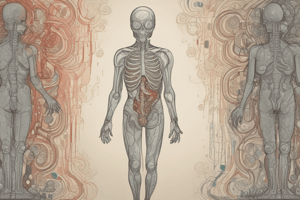Podcast
Questions and Answers
What is the main cause of infectious death worldwide?
What is the main cause of infectious death worldwide?
- HIV/AIDS
- Malaria
- Tuberculosis (correct)
- Influenza
How many distinct subgroups are there within the Mycobacterium tuberculosis complex?
How many distinct subgroups are there within the Mycobacterium tuberculosis complex?
- Seven
- Eight (correct)
- Six
- Five
What characteristic primarily makes M.tuberculosis resistant to antibiotics?
What characteristic primarily makes M.tuberculosis resistant to antibiotics?
- Presence of spores
- High content of mycolic acids (correct)
- Low virulence
- Affinity for acidic environments
In untreated cases of tuberculosis, what percentage of patients may be fatal within 5 years?
In untreated cases of tuberculosis, what percentage of patients may be fatal within 5 years?
What is the primary route of transmission for tuberculosis?
What is the primary route of transmission for tuberculosis?
Which species of Mycobacterium is most common and important in tuberculosis?
Which species of Mycobacterium is most common and important in tuberculosis?
What structural feature of M.tuberculosis increases its survival within macrophages?
What structural feature of M.tuberculosis increases its survival within macrophages?
What type of organism is M.tuberculosis categorized as?
What type of organism is M.tuberculosis categorized as?
What is the primary method of transmission for tuberculosis (TB)?
What is the primary method of transmission for tuberculosis (TB)?
Which countries accounted for two-thirds of all new TB cases reported in 2019?
Which countries accounted for two-thirds of all new TB cases reported in 2019?
What does MDR-TB stand for?
What does MDR-TB stand for?
Which of the following correctly describes XDR-TB?
Which of the following correctly describes XDR-TB?
Which of the following is a primary reason for the increase in TB cases in industrialized countries during the 1980s-90s?
Which of the following is a primary reason for the increase in TB cases in industrialized countries during the 1980s-90s?
What is the estimated percentage of MDR-TB cases that may actually be XDR-TB but remain undiagnosed?
What is the estimated percentage of MDR-TB cases that may actually be XDR-TB but remain undiagnosed?
Acid-fast bacilli are typically associated with which of the following conditions?
Acid-fast bacilli are typically associated with which of the following conditions?
In what ways can tuberculosis be transmitted through the skin?
In what ways can tuberculosis be transmitted through the skin?
Flashcards are hidden until you start studying
Study Notes
Introduction
- Tuberculosis is an ancient disease prevalent across the globe, known to affect humans for over 70,000 years.
- The global leading cause of infectious mortality.
- Commonly affects the lungs, but can impact other organs in around one-third of cases.
- Curable with appropriate treatment, with drug-susceptible strains showing high rates of successful recovery.
- Untreated tuberculosis has a high fatality rate within 5 years, affecting 50-65% of individuals.
- Transmission occurs through inhalation of infected droplets released while coughing, sneezing, or speaking.
Etiologic Agent
- Mycobacterium tuberculosis, classified in the Mycobacteriaceae family of the Actinomycetales order.
- Mycobacterium tuberculosis complex encompasses eight subgroups:
- M.tuberculosis, the most prevalent and significant.
- M.africanum, found in West, Central, and East Africa.
- M.bovis and M.caprae, zoonotic strains.
- M.pinnipedii, affecting seals and sea lions.
- M.mungi, found in mongooses.
- M.orygis, found in oryxes and bovids.
- M.microti, a less virulent strain.
- M.canetti, a rare strain, closely related to a hypothetical ancestor.
- Mycobacterium tuberculosis:
- Rod-shaped, non-spore-forming, aerobic bacterium.
- Measures approximately 0.5 μm by 3 μm.
- Acid-fast bacillus: retains stain even after acid alcohol treatment.
- High lipid content, with mycolic acids and other cell wall lipids contributing to its acid-fastness property.
- Lipids create a barrier, reducing antibiotic effectiveness.
- Lipoarabinomannan: plays a role in host interaction and facilitates survival within macrophages.
Epidemiology
- World Health Organization reported 7.1 million new tuberculosis cases in 2019, but estimated 10 million actual cases.
- Low and middle-income countries account for 97% of reported cases.
- Eight countries represent two-thirds of new cases: India, Indonesia, China, the Philippines, Pakistan, Nigeria, Bangladesh, and South Africa.
- Rise in tuberculosis cases observed in industrialized countries between the 1980s and 1990s attributed to:
- Immigration from regions with high tuberculosis prevalence.
- HIV epidemic spread.
- Social factors like poverty, homelessness, and drug abuse.
- The decline of tuberculosis services.
Epidemiology Continued
- Tuberculosis incidence remains stable or declining, at a rate of 1.7% since the 2000s.
- RR-TB (rifampin-resistant tuberculosis).
- MDR-TB (multidrug-resistant tuberculosis): Resistant to isoniazid and rifampin.
- XDR-TB (extensively drug-resistant tuberculosis): Resistant to powerful second-line drugs including fluoroquinolones and at least one injectable drug (amikacin, kanamycin, or capreomycin).
- Diagnostic challenges: Only 44% of XDR-TB cases are identified due to inadequate culture and drug susceptibility testing capacity.
- WHO's updated definitions:
- Pre-XDR-TB: MDR/RR-TB with resistance to any fluoroquinolone.
- XDR-TB: MDR/RR-TB with resistance to any fluoroquinolone and at least one Group A drug (levofloxacin, moxifloxacin, bedaquiline, or linezolid).
- Approximately 6.2% of MDR-TB cases are potentially XDR-TB, but often go undetected due to limited drug susceptibility testing capacity
Exposure to Infection
- Primarily through inhalation of droplet nuclei aerosolized during coughing, sneezing, or speaking.
- Other routes:
- Skin, placenta, but generally uncommon.
- Droplet nuclei:
- Tiny particles that quickly dry.
- Smallest particles, measuring less than 5 μm, are most effective in transmission, as larger particles are often trapped in the upper airways and expelled by cilia.
Studying That Suits You
Use AI to generate personalized quizzes and flashcards to suit your learning preferences.





